Genesis of the XK 120
The Jaguar XK 120 was introduced at the London Motor Exhibition
in October of 1948. Originally it was supposed to be merely a
showcase vehicle for Jaguar.s new 6 cylinder engine (developed
for their Mk. VII Saloon) and production was to be limited at
200 units. When the car received such an overwhelming reaction
at the exhibition, Jaguar knew it must change its plans and began
tooling for full production. Many were skeptical that the car could
achieve the advertised top speed of 120 mph (for which the car
was named). In order to squelch the skeptics, Jaguar set out to
demonstrate the car.s capabilities on the Jabbeke highway in
Belgium. In front of the assembled press, the car achieved a top
speed of 132.6 mph with the windscreen removed (126 mph in its
stock configuration), making it the fastest production car that
had ever been produced. To add perspective, the next closest
competitor of the same era, Ferrari.s Inter, could only muster a
top speed of 113 mph. Its tremendous performance enabled the
XK 120 to obtain considerable racing success in the early fifties.
Racing legend Stirling Moss won Goodwood and the Tourists Trophy
at Dundrod, Ireland driving an XK 120. Phil Hill also drove his
own XK 120 to many victories (including Pebble Beach) before
eventually becoming the first U.S. driver to win a formula one
championship in 1961 while driving for Ferrari. The XK 120 was
also the basis for the XK120C (C Type) and XK120D (D Type) cars
that won Le Mans in 1951, 1953, 1955, 1956, & 1957. Not only did
a XK 120D win Le Mans in 1957, but 120Ds also took 2nd, 3rd, 4th,
and 6th that year.
Vehicle Summary
My XK 120 was purchased by Henry Moellering in 1954. My father
purchased the car from his co-worker Henry in 1957, sold it back
to him in 1961, and then bought it back (once again) in 1971.
Dad drove the car sparingly over the years. After retiring in
1987, he began spending more time in the Jag and tried to drive
the car whenever the weather cooperated. After Dad passed away
in 1996, the car was rarely driven until I purchased it from my
mother in July of 2003. The car still retains its original Old
English White paint (officially called 'Cream') and original
interior. While not perfect, the paint and interior both look
pretty good for being over 50 years old. Since purchasing the
vehicle I've refurbished most of the fuel, electrical, cooling,
and braking system components, but still have plenty odds and
ends to keep me busy. I'll eventually attend to the paint/body
work and interior, but plan on driving it with its original
patina. for the next several years.
General Specifications (as stock)
- 160 bhp @ 5200 @ 2500 rpm
- Max Speed 132.6 mph
- 1 of 1847 produced in 1954
- Aluminum hood (bonnet), doors, and trunk (boot) lid
Powertrain
- 3442cc straight six cylinder with twin overhead cams
- Twin 1 �. S.U. H6 Carbs
- 4 Speed Moss Gearbox with synchronized 2nd (sort of), 3rd, and 4th gears
- Baffled fuel tank
Suspension
- Independent front suspension with transverse wishbones, torsion bars and hydraulic shocks
- Rigid rear axle with semi elliptic leaf springs and lever type Girling shocks
Wheels & Brakes
- Dunlop chrome 54 spoke wheels with central hubs and winged spinners
- 4 Wheel hydraulic drum brakes with tandem master cylinder
Performance Upgrades
- Pertronix electronic ignition
- Lucas high voltage .Sport Coil.
- Spax adjustable front shocks
- Brass sleeved wheel cylinders and master cylinder
|
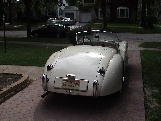
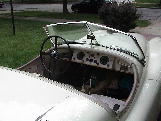
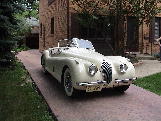
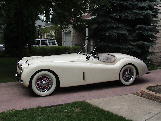
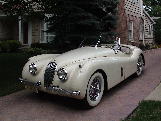
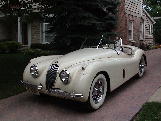
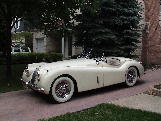
|